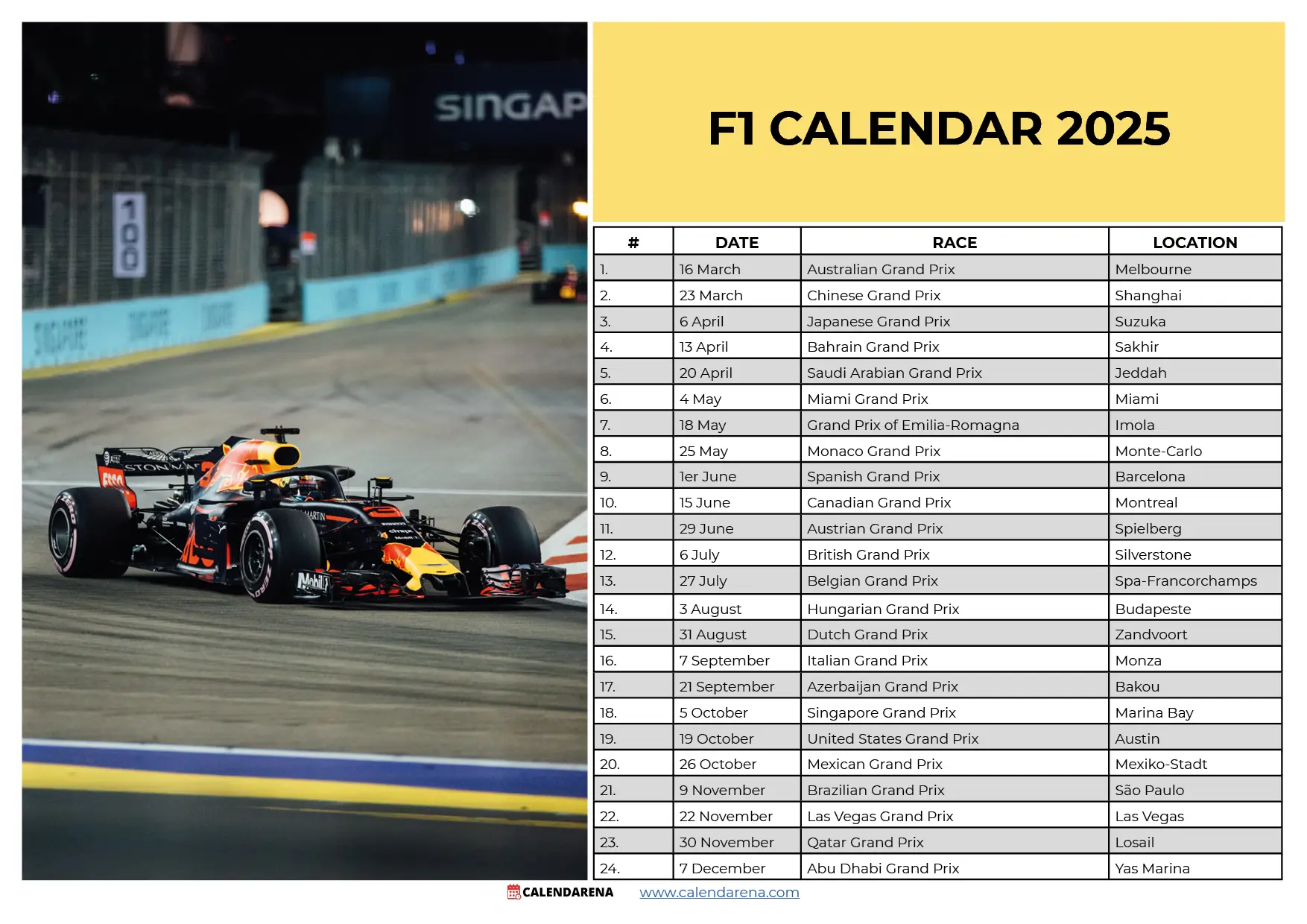
The 2025 Formula 1 Race Calendar: A Tentative Glimpse into the Future of Motorsport
The Formula 1 world championship is a relentless beast, a global spectacle that demands constant evolution and adaptation. The 2024 season is already shaping up to be a thrilling one, but the eyes of the motorsport world are already beginning to turn towards the 2025 calendar. While a definitive schedule is yet to be officially released by the FIA and Formula 1, based on current negotiations, reported interests, and the overall trajectory of the sport, we can attempt to piece together a tentative picture of what the 2025 F1 season might look like. This is, of course, speculative, and subject to change depending on track availability, logistical hurdles, and the ever-shifting geopolitical landscape.
The Established Tracks: A Foundation of Tradition and Excitement
The backbone of any Formula 1 calendar comprises its established tracks – the hallowed grounds where legends have been made and broken. We can confidently predict the presence of several iconic circuits in the 2025 season. These include:
-
Silverstone Circuit (Great Britain): The home of the British Grand Prix, Silverstone remains a cornerstone of the F1 calendar, consistently delivering thrilling races and drawing massive crowds. Its place in 2025 is virtually guaranteed.
-
Monza Circuit (Italy): The Temple of Speed, Monza, is another track with a rich history and passionate fanbase. Its high-speed nature always produces dramatic races, ensuring its continued inclusion in the 2025 season.
-
Spa-Francorchamps (Belgium): The legendary Spa-Francorchamps, known for its challenging layout and breathtaking scenery, is another track that is almost certain to feature in the 2025 calendar. Its combination of high-speed straights and demanding corners provides a true test of driver skill.
-
Circuit de Monaco (Monaco): The Monaco Grand Prix is arguably the most prestigious race on the calendar. Its unique street circuit presents a unique challenge, demanding precision and nerve from drivers. Its place in 2025 is almost certain.
-
Circuit de Barcelona-Catalunya (Spain): A popular testing ground for teams, Barcelona consistently provides exciting racing and is likely to remain a fixture in the 2025 calendar.
-
Red Bull Ring (Austria): The Red Bull Ring, with its fast corners and relatively short lap, is a popular choice among teams and fans alike. Its inclusion in 2025 is highly probable.
-
Hungaroring (Hungary): The Hungaroring, known for its challenging layout and often unpredictable weather, is another track that is likely to be part of the 2025 season.
New Additions and Potential Returns: Expanding the Global Reach
While the established tracks form the foundation, the F1 calendar is constantly evolving, seeking to expand its global reach and cater to new markets. Several potential additions and returns are being discussed for the 2025 season:
-
Las Vegas Strip Circuit (USA): The inaugural Las Vegas Grand Prix in 2023 was a resounding success, highlighting the massive potential of the American market. The inclusion of this spectacular night race in the 2025 calendar is a near certainty.
-
Kyalami Circuit (South Africa): After a successful return to the F1 calendar in 2023, Kyalami is a strong contender for a spot in the 2025 season. Its popularity and the growing interest in motorsport in Africa make it a viable option.
-
Imola Circuit (Italy): Imola, with its challenging and historic layout, has made sporadic appearances in recent years and could potentially return to the calendar in 2025, adding another Italian track to the mix.
-
Potential new venues in the Middle East or Asia: Formula 1 is continuously exploring new opportunities in rapidly developing motorsport markets. Discussions are underway with several potential venues in the Middle East and Asia, but the specifics remain unclear at this stage. These negotiations could significantly impact the final 2025 calendar.
The Challenges of Constructing the 2025 Calendar:
Creating the optimal F1 calendar is a complex undertaking involving various stakeholders, each with their own interests and priorities. Some of the major challenges include:
-
Logistical constraints: The global nature of the sport means that transporting equipment and personnel across continents poses a significant logistical challenge. Optimizing travel routes and minimizing downtime is crucial.
-
Track availability: Many circuits have limited availability due to other events or maintenance schedules. Coordination and scheduling are crucial to avoid conflicts.
-
Geopolitical factors: Global events and political instability can impact the feasibility of hosting races in certain regions. This necessitates flexibility and adaptability in calendar planning.
-
Financial considerations: The financial implications of hosting a Grand Prix are substantial, influencing the selection and prioritization of venues.
-
Fan engagement and viewing experience: The calendar needs to consider factors such as time zones, broadcasting windows, and the overall fan experience to maximize viewership and engagement.
A Tentative 2025 F1 Calendar (Speculative):
Given the above considerations, a possible (and entirely speculative) 2025 F1 calendar could look something like this (this is a sample and not a prediction):
- March: Bahrain, Saudi Arabia
- April: Australia, Azerbaijan
- May: Miami, Imola, Monaco
- June: Spain, Canada
- July: Austria, Great Britain
- August: Hungary, Belgium
- September: Netherlands, Italy
- October: Russia (Potentially), Singapore, Japan
- November: Qatar, Las Vegas, Mexico
- December: Brazil, Abu Dhabi
Conclusion:
The 2025 Formula 1 race calendar remains a work in progress, a dynamic entity shaped by numerous factors. While we can make educated guesses based on current trends and negotiations, the final schedule will likely differ from any speculative version. The anticipation, however, is palpable. The combination of established classics and potential new additions promises a thrilling season, further cementing Formula 1’s status as the pinnacle of motorsport. The coming months will reveal the official calendar, bringing with it the excitement of a new year of high-octane racing and global competition. Until then, the speculation and anticipation will continue to fuel the passion of F1 fans worldwide.



